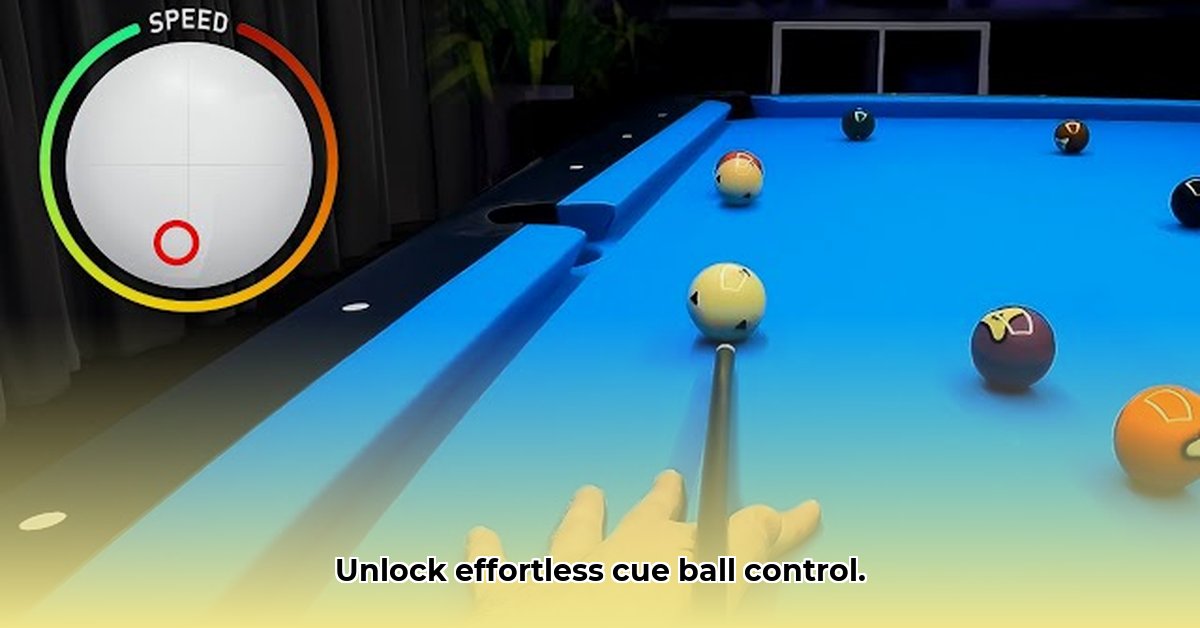
Mastering Cue Ball Control: A Step-by-Step Guide
Ready to transform your billiard game? Mastering cue ball control isn't about luck; it's about understanding the physics and developing precise technique. This guide will take you from beginner to confident player, covering everything from stance to advanced spin techniques. Let's get started!
For more in-depth cue ball control strategies, check out this helpful resource: Cue Ball Control.
Laying the Foundation: Stance, Grip, and Aim
Before hitting fancy shots, develop a solid foundation. Your stance should be comfortable yet firm, like a relaxed athlete. Avoid stiffness or excessive wobble. A balanced stance is crucial for consistency. Your grip should be firm but not tense—think of holding a baby bird. Too tight, and your shots will be erratic. Too loose, and you'll lack control. Experiment until you find the happy medium.
Aiming involves visualization. Picture the cue ball's path, where it strikes the target ball, and its subsequent trajectory. This mental rehearsal improves accuracy and reduces errors.
Understanding Spin: Your Secret Weapon
Spin, or "English," is your secret weapon. Topspin propels the cue ball forward after impact, ideal for long shots. Backspin creates a softer stop, perfect for delicate pocket shots. Sidespin makes the cue ball curve, adding an element of trickery. Experiment with different spins to understand their impact on your shots. It's akin to learning a new language – it takes time and practice, but with patience, it becomes second nature.
Don't you want to consistently predict the cue ball's path? Mastering spin is the key, allowing you to control the trajectory more effectively. This improves your shot success rate significantly. This strategic aspect makes even complex shots manageable.
Mastering Cue Ball Speed: The Art of the Touch
Control over speed is paramount. A light tap sends the cue ball gently rolling, while a firm stroke propels it across the table. Developing this sense of touch is like learning to paint – mastering the pressure on your brush to create precise strokes. Regularly practicing different speeds will build this essential skill.
Did you know that 90% of professional players emphasize the "soft touch?" Controlling speed is crucial for executing delicate shots accurately which showcases the need for mastering this critical skill. This subtlety in speed control is the difference between amateur and pro-level play.
Advanced Control: Combining Spins and Strategic Shot Planning
Combining spins unlocks exciting possibilities. Blend top and sidespin for challenging bank shots. This advanced technique allows you to control the cue ball's trajectory with remarkable precision, adding finesse to your game.
Strategic planning is as crucial as spin. Anticipate not just the current shot but the cue ball's position for subsequent shots. It's like playing chess – every move impacts the game's outcome.
Practice Drills: Honing Your Skills
Consistent practice is essential for improvement. Try these drills:
- Stop Shots: Focus on stopping the cue ball near the target ball, honing your backspin control.
- Follow Shots: Practice directing the cue ball's path after striking the target ball, improving your precision.
- Combination Shots: Combine stop and follow shots for complex sequences, demanding strategic thinking and precise execution.
Remember, consistency is key!
"Patience and dedication are crucial," says Dr. David Alciatore, Ph.D., author of Dr. Dave's Billiards. "Mastering cue ball control takes time but is immensely rewarding."
Troubleshooting Common Problems
Let's address some common issues:
| Problem | Possible Causes | Solution |
|---|---|---|
| Inconsistent Strokes | Poor stance, inconsistent grip, poor follow-through | Refine stance and grip. Analyze your stroke using video or a metronome. |
| Cue Ball Deflection | Incorrect spin, speed, contact point | Experiment with spin and contact point. Adjust your stroke. |
| Lack of Follow Through | Rushing shots, poor form | Focus on a complete stroke. Slow down and concentrate on smooth movement. |
The Mental Game: Focus and Strategy
Billiards is a mental game as much as a physical one. Maintain focus! Develop a pre-shot routine to center yourself. Visualizing the shot enhances accuracy. Manage pressure; it impairs concentration and hand-eye coordination.
Mastering cue ball control involves a physical and mental aspect. Concentrating and planning your next shot can significantly improve success rate. Every shot is an opportunity to improve your concentration.
Predicting Cue Ball Throw and Shot Adjustment
Predicting the cue ball's path after impact is critical for consistent success. Several factors influence its trajectory: the point of contact on the cue ball (center, thin, or thick), English, and shot force.
Using the 30° Rule (A Basic Starting Point)
The 30° rule provides a simple starting point but is only an estimation. However, it’s a great starting point for beginners.
- Step 1: Identify the tangent line at the point of contact on the object ball.
- Step 2: Visualize a 30° angle from that line.
- Step 3: Adjust your aim accordingly.
Remember that this rule is an approximation, particularly for shots far from the center.
Refining Prediction: Beyond the Basics
For more precise predictions, especially for thin and thick shots, advanced techniques are needed. The "peace sign" technique provides a visual aid for visualizing how the cue ball will move for mid-range strikes.
For complex caroms, the Rolling Carom Angle (RCA) system offers greater accuracy but requires more practice and understanding of physics. Accurate prediction will become intuitive the more you practice.
Adjusting Your Shots Based on Predictions
After predicting the cue ball's path, adjust your aim accordingly. If the cue ball will deflect away from your target pocket, you will need to reposition your aim and shot accordingly. Practice will help perfect this aspect.
Mastering cue ball control is a continuous journey, requiring dedication, practice, and a keen eye for detail. Enjoy the process and never stop learning!